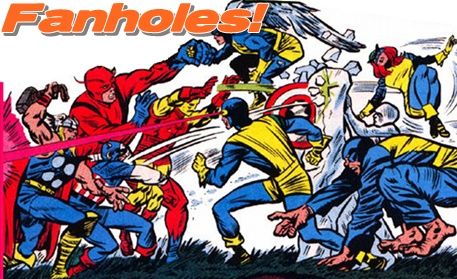
The Fanholes go Someplace Cold to discuss Mark Millar's Wolverine storyline "Old Man Logan", then share their thoughts on Marvel's 2012 crossover event "AVX".
Fanholes Episode # 77: No Silent Judgment For Hillbilly Hulks

Dungeons & Dragons B7 Rahasia (9115)

Rahasia is a Basic Dungeons and Dragons module written by Tracey and Laura Hickman (probably most famous for writing and creating the DragonLance series). Up until fairly recently, I never read or played through this module. However, back in early spring I ran the party I'm DM'ing through this module, as it worked well into my campaign (which is running through about 1/2 the classic B series modules). While "officially" set in the Known World/Mystara campaign world (like the rest of the B-Series), the module is pretty generic enough (with no true "name" places) that it can be easily placed into any campaign setting. The basic plot involves the PC's discovering than an elven village has come under the power of a person known as "Rahib". He has kidnapped two maidens, taken over a temple and brainwashed almost half the village into serving him and will not stop until the last maiden, Rahasia, turns herself in. Needless to say, it's up to the PC's to stop him! B7 originally appeared as two modules for the RPGA which were combined into one for mass-publication.

The module starts out pretty straight forward as the PC's wander into the situation the elven village is going through and get the run-down from Rahasia herself (daughter of the leader of he village). Because of this, the PC's know not to try to kill every elf they come across since they're maybe brainwashed (unless, of course, they really want to but DM's could start docking XP for that if there are other ways). There are some challenging combats (especially for 1-3 level PC's!) and a lot of puzzles, traps, and tricks. One of the "nasty" aspects of the temple are the transporters which can bring a PC even deeper into the complex, alone (our cleric went into one but thankfully it dumped her outside the temple), or into the hands of the enemy. The PC's also discover that something more sinister is going on! The ancient wizard ruins, ghosts, and guardians let the PC's onto even deeper secrets and the horrors that can be unleashed if the Rahib is successful in his plan!

Although meant as an introductory module (as is the whole B series) for levels 1-3, even 4-5 level PC's will find this module very challenging. In one nasty combat encounter, 2 out of 5 PC's went down in the first two rounds (granted, the PC's aren't really suppose to fight this one monster, according to the module). At another point, two more were turned into statues (with no saves allowed). For gaming groups used to straight forward dungeon crawls where you kill all the monsters and take all the treasure, they will find a lot of challenges here. From the transporter traps, to puzzles, mysteries, and the final maze, it requires thinking and remembering what has gone before.

The artwork is pretty standard for TSR at the time. The cover, back page, and the wilderness map are in color while the rest of the module is black and white (with a couple full-page drawings). Tim Truman and Jeff Easely (who also did the cover) are the interior artists (they were TSR "regulars" for art). Like most TSR products, he maps are great and easy to use for a DM (though players might have a difficult time with the map due to the transporters).

Rahasia does include a few new monsters, including the water weird, haunt, and bone golem. It does have a new magical item but it is story-specific and really isn't too helpful outside of the module. Like most modules, there is also a set of pre-generated characters (sometimes they were the ones used if it began life as a tournament module).

For a B series module, especially in the time period it was written, Rahasia is a wonderful module. An excellent plot that goes beyond a simple "here is some money, go clear out the dungeon" that many of the B series has. Unlike other B modules, there are no teaching tools built into the module (B1, B2, B11 all have sections on how to run a game for both DM's and players). Rahasia is a good example of what DM's can do in their own modules. It requires the PC's to think beyond the sword which serves to make Rahasia a gem of the time period. If you get a chance, at least read it. If you've never run it or played through it, try to. You will be surprised. And for fiendish DM's, it's a good way to teach PC's the importance of talk, listen, see, and remember.

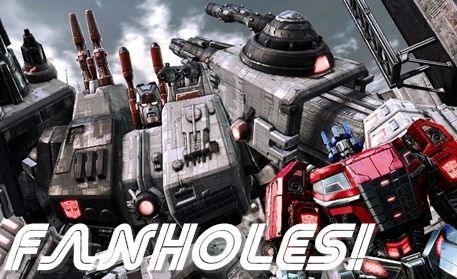
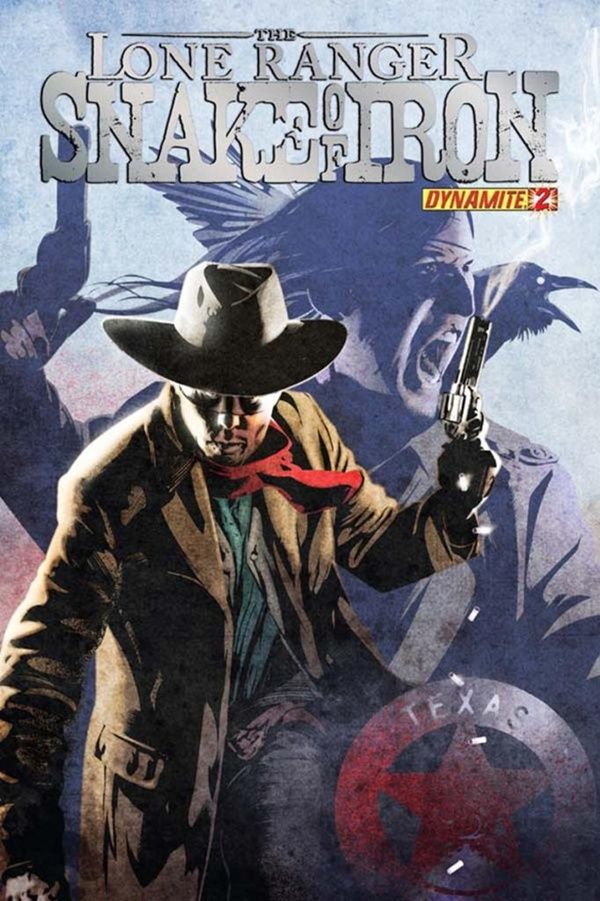 The Lone Ranger: Snake of Iron is a four issue mini-series published by Dynamite and written by Chuck Dixon with art by Esteve Polls. The Lone Ranger searches for a Spirit Horse to prevent local Indian tribes from going to war while Tonto must keep a derailed train full of civilians safe from an Indian attack. The Spirit Horse turns out to be a camel, with its owner being a young newspaper woman from Chicago. Like all good reporters she is captured by a gang of bandits and renegades and, of course, must be rescued by the Lone Ranger.
The Lone Ranger: Snake of Iron is a four issue mini-series published by Dynamite and written by Chuck Dixon with art by Esteve Polls. The Lone Ranger searches for a Spirit Horse to prevent local Indian tribes from going to war while Tonto must keep a derailed train full of civilians safe from an Indian attack. The Spirit Horse turns out to be a camel, with its owner being a young newspaper woman from Chicago. Like all good reporters she is captured by a gang of bandits and renegades and, of course, must be rescued by the Lone Ranger.
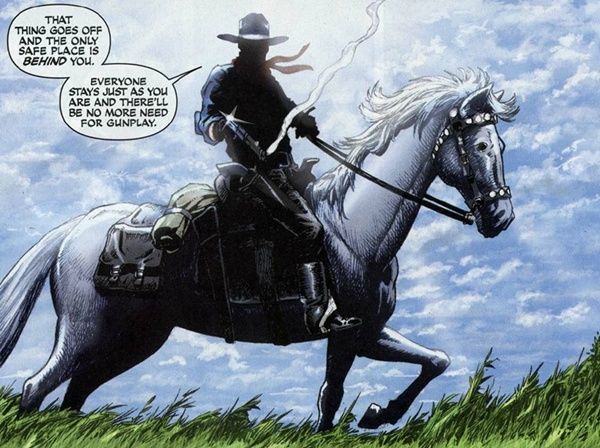 Tonto discovers that the Indians are after an Indian boy who has been ‘civilized’. Tonto sends his horse Scout to locate The Lone Ranger. The situation on the train grows intense with repeated Indian assaults. The passengers begin to debate if they should simply turn the boy over. Tonto proclaims anyone that attempts to do so will have to go through him.
Tonto discovers that the Indians are after an Indian boy who has been ‘civilized’. Tonto sends his horse Scout to locate The Lone Ranger. The situation on the train grows intense with repeated Indian assaults. The passengers begin to debate if they should simply turn the boy over. Tonto proclaims anyone that attempts to do so will have to go through him.
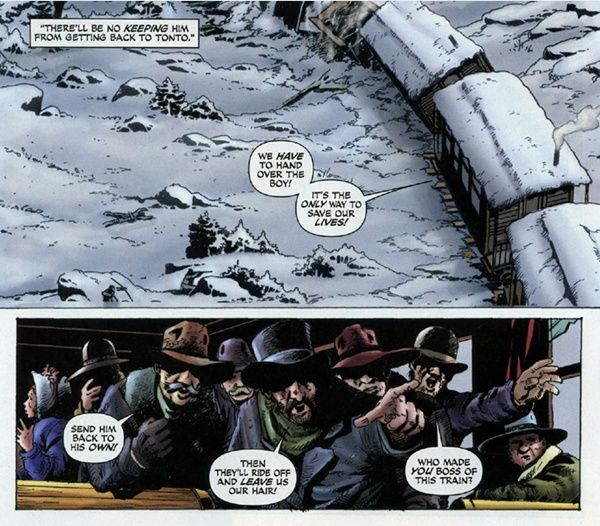 After dodging wolves and other Indians Scout manages to locate the Lone Ranger in the middle of a snow storm. Tonto decides to ride out with the boy and talk peace. The boy’s father is killed and as the Indians continue the attack the ‘spirit horse’ arrives and the Indians give up.
After dodging wolves and other Indians Scout manages to locate the Lone Ranger in the middle of a snow storm. Tonto decides to ride out with the boy and talk peace. The boy’s father is killed and as the Indians continue the attack the ‘spirit horse’ arrives and the Indians give up.
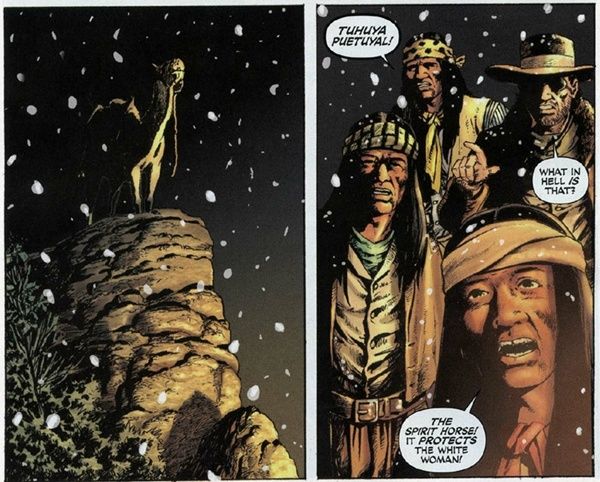 Dynamite has been producing comic books featuring The Lone Ranger and Tonto since 2006. These comics are set in a more realistic world full of the usual trappings of violence. There are several different volumes and minis and, in my opinion, all are worth reading (except The Lone Ranger and Zorro: The Death of Zorro). If you’ve never picked up a Lone Ranger comic Snake of Iron might be a good place to start. There is no heavy story arc here, just a one off adventure.
Dynamite has been producing comic books featuring The Lone Ranger and Tonto since 2006. These comics are set in a more realistic world full of the usual trappings of violence. There are several different volumes and minis and, in my opinion, all are worth reading (except The Lone Ranger and Zorro: The Death of Zorro). If you’ve never picked up a Lone Ranger comic Snake of Iron might be a good place to start. There is no heavy story arc here, just a one off adventure.
